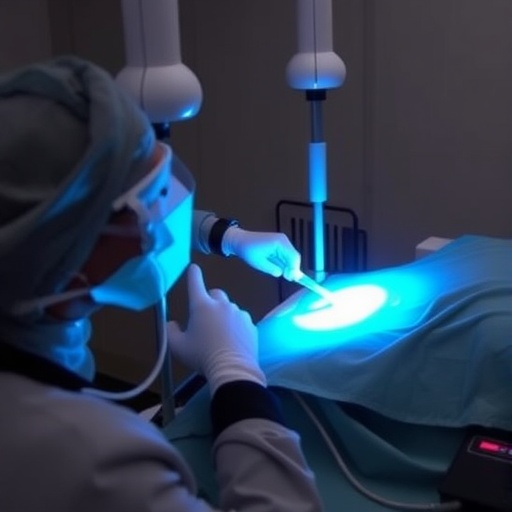Recent advancements in artificial intelligence have opened new avenues in healthcare, especially in the realm of surgical procedures. One of the most intriguing developments comes from a recent study examining the use of a YOLO-based (You Only Look Once) approach to enhance the precision of tracheal intubation. This critical skill, often performed in emergency settings, is essential for ensuring adequate ventilation and oxygenation in patients who are unable to breathe on their own. As medical professionals strive for optimal patient outcomes, employing advanced technologies like YOLO could represent a significant step forward in respiratory management.
The YOLO framework, renowned for its real-time object detection capabilities, has begun to make its mark beyond traditional application areas such as computer vision and video analysis. Researchers Huang, Wu, and Tseng have harnessed this powerful tool, tailoring it specifically for the medical field. Their innovative approach aims to provide exact visualization of key anatomical structures during tracheal intubation. This could mitigate risks associated with the procedure, such as damage to surrounding tissues or failure to secure the airway, thus enhancing patient safety and care quality.
Tracheal intubation itself is a challenging procedure that requires a high degree of skill and anatomical knowledge. In emergency situations, rapid and accurate decision-making is crucial—something that can be overwhelming in high-pressure environments. Traditional methods often rely on manual visualization and experienced judgment, which can vary significantly among practitioners. By integrating YOLO technology, healthcare providers could benefit from augmented awareness of the patient’s anatomical layout, effectively enhancing their decision-making capabilities under stress.
The study’s authors have meticulously outlined how the YOLO-based system operates. Initially, the model is trained using an extensive dataset of annotated images highlighting various anatomical structures relevant to intubation. This training phase is critical, as it allows the model to identify and categorize different tissues and organs accurately. The researchers then test the system’s performance in simulated scenarios, comparing its visual output to that of skilled practitioners. The results show promise, indicating that the YOLO model can match or even surpass human accuracy in certain instances.
Moreover, the implications of this technology reach far beyond simple object detection. Its ability to provide real-time feedback during intubation can facilitate better training for medical students and residents. With this support, novices could quickly learn how to navigate complex anatomical landscapes, building confidence before they approach patients. Incorporating these tools in medical education could lead to a new era of less stressful learning environments, where technology plays an integral role in nurturing future professionals.
The potential to standardize techniques across the medical community is another significant benefit of this development. Variability in performance can lead to discrepancies in patient outcomes, especially in life-or-death situations like intubation. By establishing a consistent framework for anatomical identification, the YOLO-based model could ensure that all practitioners adhere to an objective standard, ultimately promoting uniformity in care.
Additionally, healthcare facilities could automate aspects of the intubation process, which may reduce the cognitive load on medical providers. By streamlining this crucial intervention, practitioners would be able to devote their cognitive resources to other critical components of patient care. Such advancements in efficiency could lead to overall improvements in healthcare delivery, particularly in emergency departments where rapid response is essential.
Nonetheless, the research does not come without its challenges and considerations. The implementation of AI-driven systems in clinical environments raises questions about reliability, system errors, and the necessity of human oversight. Trusting a machine to perform critical tasks requires addressing these concerns head-on, ensuring that rigorous validation processes are in place before widespread adoption. Furthermore, integrating new technologies into existing workflows can pose logistical complications, necessitating extensive training and adaptation by all staff members involved.
Ethical implications also surface when discussing AI in medical practice. As technology becomes more prevalent in decision-making processes, practitioners must ensure that their clinical judgment remains paramount. While AI can aid in enhancing outcomes, it must be viewed as a complementary tool rather than a replacement for human expertise and empathy. Balancing the strengths of both AI and human intuition will be critical in maintaining quality patient care.
As researchers continue to refine and validate their methods, this innovative application of YOLO technology could redefine how healthcare providers approach tracheal intubation. The ability to accurately identify key anatomical targets would undeniably enhance the safety and effectiveness of the procedure, ultimately benefiting patient outcomes. As we stand on the precipice of a technological revolution in healthcare, exploring these advances opens the door to a future where AI and medicine seamlessly coexist to save lives.
In conclusion, the integration of YOLO-based systems in tracheal intubation represents a striking manifestation of how technology can transform traditional medical procedures. With ongoing research and refinement, this novel approach could pioneer a path toward higher standards of practice in critical care settings. Though hurdles remain, the potential to improve patient safety and practitioner confidence is undeniable. As healthcare technology continues to evolve, the collaboration between artificial intelligence and human expertise will pave the way for enhanced medical practices in the years to come.
Subject of Research: Use of YOLO technology for anatomical target identification in tracheal intubation.
Article Title: Application of YOLO-Based for Precise Identification of Critical Anatomical Targets in Tracheal Intubation.
Article References:
Huang, KY., Wu, YH., Tseng, CC. et al. Application of YOLO-Based for Precise Identification of Critical Anatomical Targets in Tracheal Intubation.
J. Med. Biol. Eng. (2025). https://doi.org/10.1007/s40846-025-00992-x
Image Credits: AI Generated
DOI: https://doi.org/10.1007/s40846-025-00992-x
Keywords: AI, YOLO, tracheal intubation, healthcare technology, surgical precision, emergency medicine.




